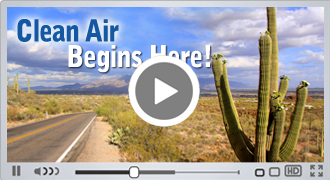Emissions Testing Is Essential
The quality of the air we breathe is more important than ever. All Arizonans deserve the cleanest possible air today, for our future -- especially those with compromised health. We all can make a positive difference by the choices we make and actions we take everyday. Vehicle emissions contribute to increased levels of air pollution like man-made ozone and particulate matter (smoke and dust). And, for the millions of Arizonans who choose to own and operate motor vehicles, each plays an important role in maintaining and improving Arizona's air quality by simply testing vehicle emissions to ensure they meet health-based standards.
Why Emissions Testing is Required
Vehicle emissions testing is required in major metropolitan areas that are not meeting federal air quality standards for ozone and other pollutants. In Arizona, testing is required in the Phoenix and Tucson metropolitan areas, where ozone and particulate matter pollution are a problem.
Why is ozone and particulate matter pollution a problem?
Ozone and particulate matter pollution exacerbates breathing-related illnesses such as bronchitis, emphysema, asthma, chronic obstructive pulmonary disorder (COPD), and other respiratory or pulmonary issues. The science linking ozone and particulate matter pollution to negative health effects is extensive:
- PHYS ORG: One Million Premature Deaths Linked to Ozone Air Pollution | View Page >
- Harvard Study: Exposure to air pollution and COVID-19 mortality in the United States | View/Download >
- Martin-Luther University Halle-Wittenberg (Germany): Assessing nitrogen dioxide (NO2) levels as a contributing factor to coronavirus (COVID-19) fatality | View >
- American Lung Association: Ozone | View Page >
- EPA: Health Effects of Ozone Pollution | View Page >
- CDC: Particulate Matter Pollution | View Page >
What to expect when you come to test your vehicle emissions:
- Pull your car into the station, put it in park and apply your emergency brake. If your vehicle is a manual transmission, ensure you put it in neutral
- Choose where you are most comfortable waiting for test to be completed: the waiting booth, waiting area or outside
- While you are waiting the inspector performs the On-Board Diagnostic (OBD) test -- without getting into your vehicle -- the inspector reaches in to connect the OBD cord to the data link connector (DLC)
- Once that is complete, you will be asked to return to your vehicle to turn the ignition key to the accessory position, so the inspector can verify the check engine light is functioning
- You will then start your vehicle, allowing the inspector to observe that the check engine light turns off from a safe distance
- After the OBD test is complete, you will turn off the vehicle and exit to the waiting area of your choice (waiting booth, waiting area or outside)
- When payment is due, simply inserts your credit card and remove when processing is complete
- You then return to your vehicle, and the inspector finishes the test process and delivers your vehicle information report




